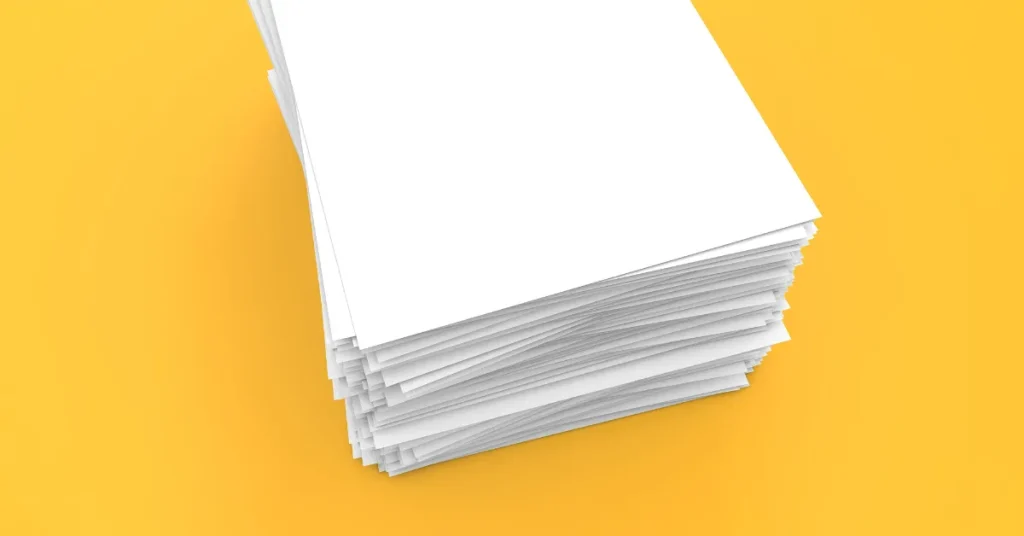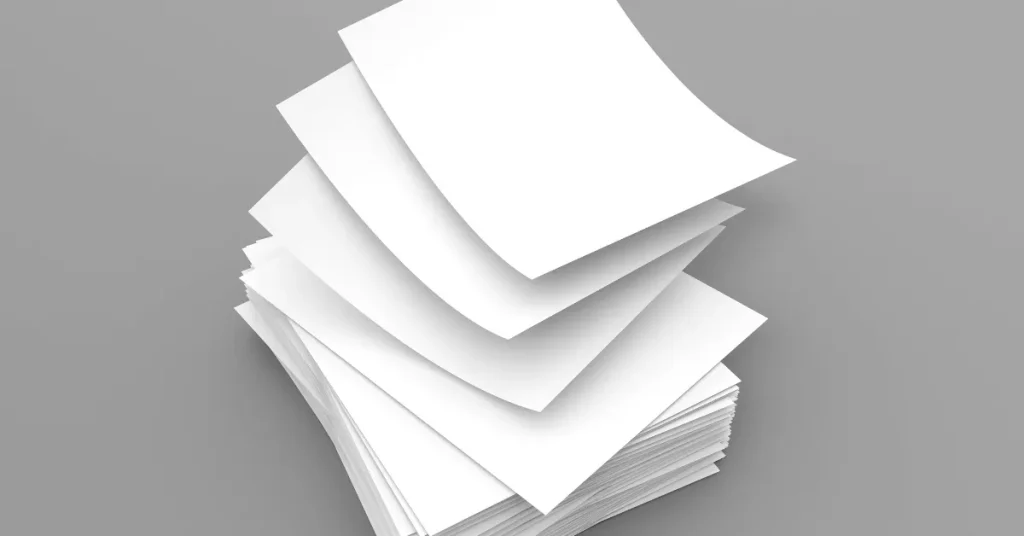The thickness of standard A4 paper is typically around 0.1mm. A4 paper is a common size used globally for a variety of documents.
A4 paper is an international standard, with dimensions of 210 x 297 mm, widely used for letters, forms, and printing. Its uniform size and thickness make it convenient for handling, filing, and shipping across different industries and personal uses.
Ideal for everyday use, this paper is easily compatible with most printing devices, which contributes to its popularity in both professional and academic settings.
Despite its thinness, A4 paper maintains a balance between durability and flexibility, making it suitable for an array of tasks, from drafting documents to creating pamphlets.
With the rise of digital communication, the importance of A4 paper remains significant, as it continues to be essential for official paperwork, legal documents, and educational materials.

The Basics Of A4 Paper Dimensions
The Basics of A4 Paper Dimensions dive into the world of stationery. A4, a size familiar to many, stands as the go-to paper format for documents. Its measurements are uniform, making it the standard in many countries.
A4 strikes the perfect balance, neither too big nor too small. It provides ample space for text and images, fitting neatly into binders and printers. Understanding the specifics of this size is key for everyday tasks.
A Snapshot Of International Paper Standards
Paper comes in various sizes, with the A series dominating globally. Originating from the ISO 216 standard, this series ensures consistency.
A4 reigns within this system, coming in after A3 and before A5. Its precision spans continents, aiding in international communication. Listed below are the specifics about A4 and its role in the A series of papers:
- A4 Size: 210 x 297 mm or 8.27 x 11.69 inches
- A Series Paper: Each size is half the one before it
- Compatibility: Fits standard printers and copiers
A4 Paper In Daily Use
A4 paper is a staple in daily life. Found in offices, schools, and homes, its ubiquitous nature is undisputed. This paper size serves many purposes, outlined in the points below:
- Printing Documents: Resumes, letters, and reports
- Education: Worksheets, notes, and project pages
- Art and Crafts: Drawings, flyers, and origami
Its thickness varies by weight, often noted as grams per square meter(g/m²). The standard office paper usually ranges around 80 g/m². This makes it thick enough for most printing needs without being overly hefty.
Measuring Paper Thickness

Understanding the actual thickness of A4 paper is important. It defines its feel, quality, and suitability for different uses. Let’s explore how to accurately measure this staple of office and school life.
From Micrometers To Grammage
Paper thickness can be a bit tricky. It often goes beyond a simple ruler measurement.
A4 paper thickness is typically expressed in micrometers, also known as microns, or via its grammage—its weight per square meter.
This number can give an idea of thickness without direct measurement.
| Grammage (gsm) | Estimated Thickness (microns) |
| 80 gsm | ~100 microns |
| 100 gsm | ~120-130 microns |
| 160 gsm | ~160-170 microns |
In essence, the higher the grammage, the thicker the paper. Yet, there’s no exact rule because different materials differ in density.
Tools For Assessing Paper Thickness
Proper tools can help you pinpoint paper thickness. Standard rulers won’t catch the subtle differences, but there are specialized tools that can.
- Micrometer Screw Gauge: A precision device that measures small distances. It’s ideal for thin materials like paper.
- Digital Calipers: These give a precise digital readout and are useful for thicker stacks of paper.
- Paper Thickness Gauges: Specially made for paper products, these can offer very accurate measurements.
Collecting data using these tools will give you a more accurate sense of paper thickness. A digital caliper, for example, will show you the thickness down to a hundredth of a millimeter.
As you measure, ensure the paper is uncompressed for the best result. Each tool provides its own level of precision, so choose based on your needs.
The Surprising Truth About A4 Paper Thickness
Think A4 paper is just everyday thin paper? Think again. The truth about A4 paper thickness might just surprise you. What seems like a simple sheet holds a world of variation. Let’s unfold the story of A4 paper thickness and discover what sets each sheet apart.
Average Thickness Revealed
Believe it or not, A4 paper thickness isn’t one-size-fits-all. On average, a single sheet of A4 paper is about 0.1 millimeters thick. That’s as thin as a human hair! This measurement means if you stack 100 sheets, it would rise to about 1 centimeter high.
Factors Influencing Thickness Variation
Several factors can change the thickness of A4 paper:
- Paper weight (GSM): Heavier, higher GSM paper is thicker.
- Humidity: Moisture can cause paper to expand.
- Production process: Different milling processes affect paper size.
Understanding these elements is key to selecting the right A4 paper for your needs.
Impact Of Thickness On Printing And Usage
The thickness of A4 paper is more than just a physical attribute. It has real consequences for both printing quality and the paper’s application.
Choosing the right paper thickness is crucial for professional results and efficient usage.
Print Quality And Paper Thickness
Thicker paper often yields better print quality, supporting higher ink absorption and less bleed-through. This leads to sharper images and text. Users must consider their printer’s capabilities.
Not all printers handle thick paper well. High-quality printers match up with thicker A4 paper for premium results.
Choosing The Right Thickness For Your Needs
Paper thickness is measured in grams per square meter (gsm). Standard A4 paper typically ranges from 70 to 90 gsm.
More robust uses require thicker paper, from 100 to 130 gsm.
Consider these factors when selecting paper thickness:
- Intended use: Manuals need sturdier paper than memos.
- Printing method: Laser printers prefer certain thicknesses.
- Post-processing: Will the paper be folded or bound?
Beyond A4: Comparing Paper Thickness Across Formats
Understanding paper thickness across different formats helps in making the best choice for printing needs.
The common A4 paper that we use has a specific thickness. Yet, other sizes differ in thickness, affecting durability, feel, and print quality. This section dives into the varied thickness of different paper sizes and how to choose the right one.
Thickness Differences In Various Paper Sizes
Paper comes in a range of sizes and weights, each with its own thickness. Thickness can tell a lot about a paper’s quality and its best use. Let’s look at some common paper sizes and their typical thickness comparisons.
| Paper Size | Thickness (micrometres) |
| A4 | 90-120 |
| A3 | 90-120 |
| A5 | 90-120 |
| Letter | 90-120 |
| Legal | 90-120 |
| Cardstock | 150-300 |
Note: Thickness can vary based on paper quality and manufacturer.
Choosing Between Paper Formats
When picking a paper format, consider the project’s purpose. Below are some factors to help decision-making:
- Print Type: High-quality images need thicker paper.
- Purpose: Invitations require sturdier paper like cardstock.
- Budget: Thicker paper often costs more.
- Equipment: Some printers can’t handle thick paper well.
Select a format that strikes a balance between these aspects.
Preserving The Integrity Of A4 Paper

The thickness of A4 paper plays a crucial role in various applications.
Maintaining the original thickness ensures longevity and functionality.
Learn how to keep your paper in top condition below.
Proper Storage To Maintain Thickness
Storing A4 paper correctly is essential for preserving its thickness and quality.
Follow these steps for optimal paper care:
- Avoid damp areas: Store in a dry place to prevent moisture absorption.
- Keep away from heat: Heat can cause paper to dry out and become brittle.
- Use a flat surface: Prevents bending and keeps paper flat.
- Limit exposure to light: Light can lead to fading and weakening.
Consider using storage boxes or file cabinets for large quantities of paper.
Affect Of Environmental Conditions On Paper
Environmental conditions can alter A4 paper in ways one may not expect.
The table below illustrates the potential changes:
| Condition | Effect on Thickness |
| High Humidity | Increased swelling and potential warping |
| Low Humidity | Shrinkage and brittleness |
| Temperature Fluctuations | Expansion and contraction can alter thickness |
Control the environment where you keep your A4 papers.
Use climate control if possible. This helps prevent changes in paper quality and thickness.
FAQs About How Thick Is A4 Paper
What Thickness Is Normal A4 Paper?
Normal A4 paper typically has a thickness of 80 grams per square meter (gsm). This standard weight equates to a thickness of about 0. 097 millimeters or 0. 0039 inches.
What Is The Thickness Of A Sheet Of Paper?
The average thickness of a standard sheet of paper is about 0. 1 millimeters.
What Is The Thickness Of A4 Paper In Microns?
The thickness of standard A4 paper typically ranges from 70 to 180 microns.
How Thick Is A4 Paper 3d Printing?
A4 paper thickness for 3D printing typically ranges from 0. 05mm to 0. 2mm, depending on the desired object strength and printer specifications.
Conclusion
Understanding the dimensions of A4 paper, including its 0. 1 mm thickness, matters for both personal and professional projects. Choosing the correct paper impacts print quality, mailing costs, and durability of documents.
Remember this detail and ensure your endeavors on paper are as successful as they are impressive.
Resources:
1. https://www.uspto.gov/web/offices/pac/mpep/s1825.html
